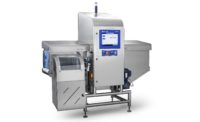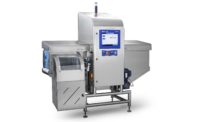New Mettler Toledo X39 X-ray Inspection System conducts ten product integrity checks in one inspection pass

The new X39 X-ray inspection system designed by Mettler-Toledo Safeline now enables manufacturers of frozen formed burger patties (beef, pork, chicken, fish and vegetarian) to detect and reject non-conforming products, including both those containing contaminants and those with other product irregularities or defects. The X39 employs a two-stage inspection process. Stage one is an integrated laser technology preliminary brand integrity check for flake defects, and length, width and height irregularities. (Flakes are small pieces of uncooked product that can land on a patty during the forming process, before the entire product is frozen. There is a risk that the underside of the flake will not be 100% cooked.) This inspection takes place regardless of product position. A single bank of air nozzles and a reject flap immediately removes individual substandard products from the conveyor.
In the second inspection stage, X39 X-ray detector consecutively inspects the remaining good products for foreign-body contaminants, such as calcified bone, mineral, stone, glass, metal and high-density plastic, and additional product defects, including holes, dents, edge deformities, mass and shape. Air nozzles reject substandard product into a secondary rework receptacle, further minimizing waste, ensuring brand integrity and upholding food safety requirements.
This two-fold product inspection system and highly-precise reject capability takes place across multiple production lanes, enabling manufacturers to rework products detected by each examination stage, significantly reducing waste and protecting bottom line savings. The X39 operates at 60 meters a minute. For example: it can conduct 10 integrity checks of 300 pieces a minute per lane based on 100 mm patties across 6 lanes, with an approximately 100 mm gap between each product.
Mettler-Toledo developed the X39’s inspection process and technology in response to the evolving demands of frozen formed food processors and manufacturers. The intelligent set-up software of the laser technology, X-ray and reject devices reduces manual operator installation time and potential product identification errors. The X39’s laser is pre-programmed with specific product characteristics–the height, width and length of the frozen formed food product. The high resolution visualization capabilities of the laser, scanning across 4, 6, or even 7 production lanes, can identify specific defects, such as flakes, on the randomly placed products.
The system’s reject nozzles use jets of air to remove all non-conforming products, through a gap between consecutive conveyors, into a primary rework bin for sorting. The pre-set gap width is tracked by linear technology and, if the space needs to be altered, the system software will alert the operator. If the product is too large to fit through the pre-programmed gap–for example, if two patties join together–then a second-stage rejection flap will automatically remove the item.
The advanced X39 software also monitors system performance to ensure that the technology is always working at precision levels. The software monitors all aspects of the system, providing assessments of the accuracy of the lasers, reject nozzles and confirmation sensors. A row of reject sensors can be easily removed from the system and cleaned collectively, or individual sensors can be replaced, without stopping production. In addition, the system software records and stores all inspection results for due diligence and food safety legislation requirements.
The X39’s sophisticated software is designed to ensure that the technology is always fully optimized to work at high precision levels and, if system replacements are needed, that alerts help ensure that uptime is maximized. The software monitors all aspects of the system, providing assessments of the accuracy of the lasers, reject nozzles and confirmation sensors. A row of reject sensors can be easily removed from the system and cleaned collectively or individual sensors can be replaced without stopping production. In addition, the technology records and collects all inspection results for due diligence and food safety legislation requirements.
The X39 design follows industry recognized European Hygienic Engineering and Design Group (EHEDG) and National Sanitation Foundation (NSF) guidelines to meet the highest hygienic standards required by manufacturers working with raw food products. Anti-corrosion materials, including a stainless steel frame further enhanced with type 316 stainless steel used in key product contact areas such as reject flaps and receptacles, ensure the system’s durability and its ability to be sterilized in uncooked food production environments. The entire system is IP69 ingress protection rated to accommodate the harsh wash down schedules needed to prevent bacterial contamination. An open frame design, angled surfaces, drainage slots in catch trays and easy strip-down mechanisms, such as belts and components, facilitates easy and thorough cleaning. An integrated cleaning feature allows the system’s covers to be opened to enable in-place belt cleaning at low production speeds, reducing operational downtime.
Looking for a reprint of this article?
From high-res PDFs to custom plaques, order your copy today!






